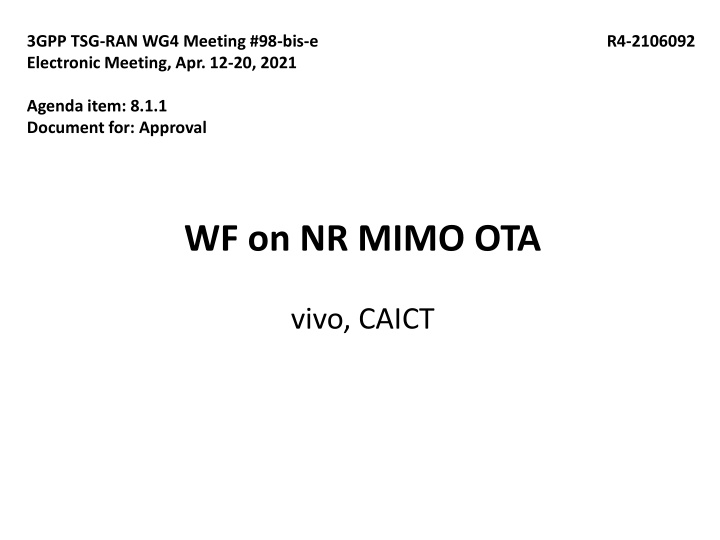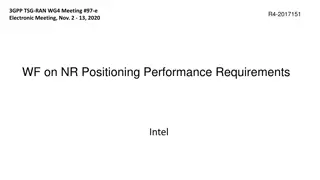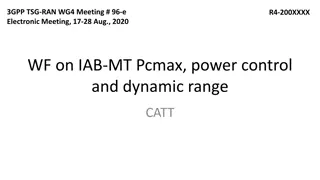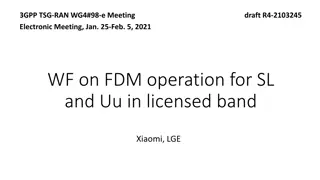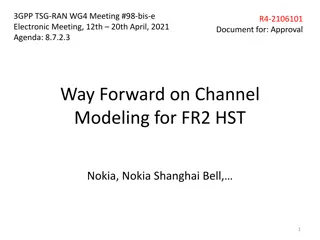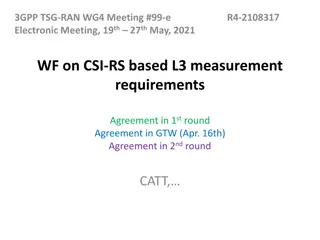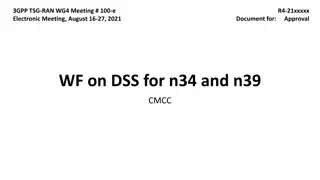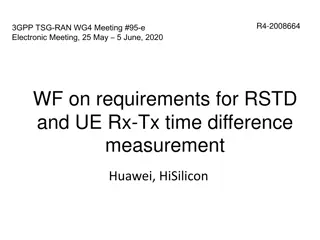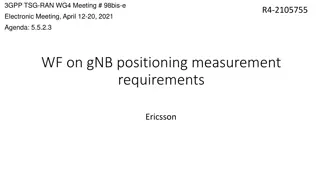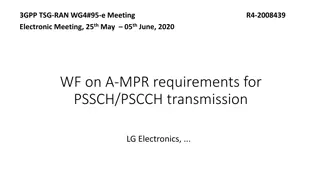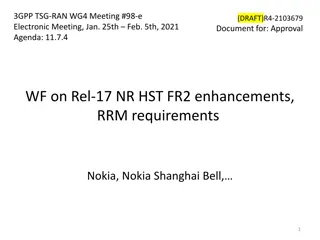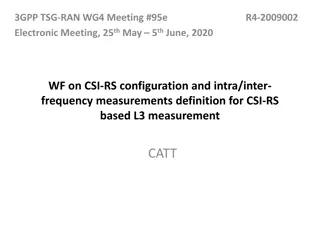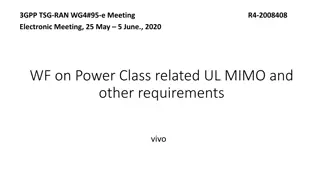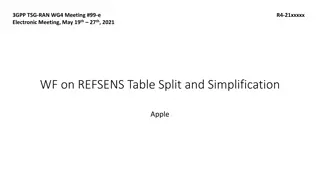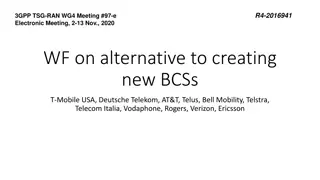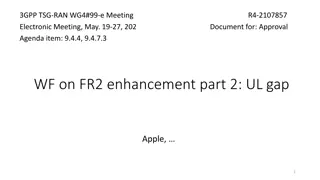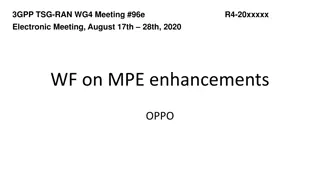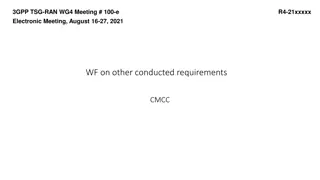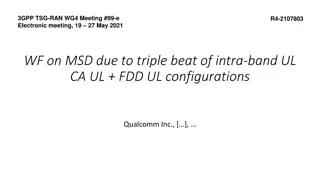Approval and Validation Updates for NR MIMO OTA in 3GPP TSG-RAN.WG4 Meeting
The 3GPP TSG-RAN.WG4 Meeting discussed approval for the NR MIMO OTA workplan, addressed FR2 blocking issues, and emphasized the use of polarized antenna models. Updates were made to the power validation procedure and gNB beams usage criteria for FR1 MIMO OTA channel model validation. Collaboration with vendors for simulation data and reference curves was encouraged for system validation. The meeting aimed to improve the efficiency and accuracy of MIMO OTA testing methods.
Download Presentation

Please find below an Image/Link to download the presentation.
The content on the website is provided AS IS for your information and personal use only. It may not be sold, licensed, or shared on other websites without obtaining consent from the author.If you encounter any issues during the download, it is possible that the publisher has removed the file from their server.
You are allowed to download the files provided on this website for personal or commercial use, subject to the condition that they are used lawfully. All files are the property of their respective owners.
The content on the website is provided AS IS for your information and personal use only. It may not be sold, licensed, or shared on other websites without obtaining consent from the author.
E N D
Presentation Transcript
3GPP TSG-RAN WG4 Meeting #98-bis-e Electronic Meeting, Apr. 12-20, 2021 R4-2106092 Agenda item: 8.1.1 Document for: Approval WF on NR MIMO OTA vivo, CAICT
General and test method Updated Workplan for MIMO OTA WI The updated workplan of NR MIMO OTA WI based on the Rel-17 timeline and RAN4 meeting plan is approved [R4-2106096] FR2 blocking issue Further study how to address the FR2 blocking issue The approach provided by Keysight could be a starting point, Three-step simulation/measurement approach to quantify the blocking issue
Channel model FR1 BS antenna element polarization Apply polarized antenna model with 45 slant angle for FR1 MIMO OTA. Use polarization model-2 of section 7.3.2 of TR 38.901 for implementing the +/-45 slant angle for FR1 antenna model. A TP is needed to add above information into spec next meeting FR2 BS antenna element polarization To provide impact analysis on FR2 BS antenna element polarization type Use polarization model-2 of section 7.3.2 of TR 38.901 FFS for the polarized antenna mode for FR2 MIMO OTA polarized antenna model (option 1) polarized antenna model with 45 slant angle (option 2) Infra-vendors are encouraged to provide the feedback on the actual implementation on FR2 BS antenna element polarization
Power validation procedure Update the power validation procedure If a horizontally polarized sleeve dipole is used for H component power validation, the horizontal positions should be at least 4. A note is needed in the power validation Measurement Procedure: Note: in step 4, if horizontally polarized sleeve dipole is used, the reference gain correction should be the average of the theta gain pattern cut of the dipole. Correct the mistake of power validation procedure For PDP, Doppler, Spatial correlation, and XPR, keep using the sub-bands grouping approach, i.e. same as quality of quite zone For power validation, some sub-bands grouping frequencies are not valid, FFS the measurement should be done per-band Option 1: Stick to sub-bands grouping approach, redefine some frequencies for power validation only Option 2: Change power validation to per-band approach The power validation results should be considered as systematic offset, which needs to be used to correct on the final sensitivity value to further reduce measurement uncertainty Further check the H component measure time with more than 4 averaging (e.g., 8 or 16) is encouraged
System validation gNB Beams for Channel model validation gNB Beams Usage Criteria for FR1 MIMO OTA Channel Model Validation Option 1: Beam specific Option 2: Combined beams Reference curve for Channel model validation Reference figure for FR1 spatial correlation validation Choose simulation curve as reference CE vendors and other companies are encouraged to provide data for generating the reference and further alignment also required. Simulated Channel model reference figure Reference figure for FR1 channel model validation Simulation results have been shared from CE vendors in [R4-2106902 R4- 2106097] Aligned results from CE vendors and other companies if any on reference channel model curve is required next RAN4 meeting.
Test Parameters for requirements Test Parameters for FR1 requirements For FR1 2x2 MIMO OTA requirements CDL-C UMi is slected as baseline to define FR1 2X2 MIMO OTA requirements PRS-EPRE-MAXfor band frequency <3GHz, 40MHz bandwidth Agreed as -80dBm/15kHz, The above value can be modified based on practical measurement in the future PRS-EPRE-MAXfor band frequency >3GHz, 40MHz bandwidth Option 1: -80dBm/15kHz (or equivalent -77dBm/30kHz) Option 2: -79dBm/15kHz (or equivalent -76dBm/30kHz) The above value can be modified based on practical measurement in the future or missing point requirements can be further modified. Test Parameters for FR2 requirements RMC for FR2 MIMO OTA: NO further discussion on CHBW parameter for FR2 requirements in RAN4 unless critical issues identified for existing agreements or consensus reached in offline
NR MIMO OTA requirements FR1 FoM: Restriction of Pmodeat 90%TP for 10MHz and 40MHz CHBW. For 10MHz and 40MHz CHBW, the [10] of total 12 PMODEshould reach 90%TP based on the current assumption of PRS-EPRE-MAXvalue The final decision will be concluded during requirement discussion stage FR2 FoM: Refinement of MASC calculation FR2 MASC is the average of top N points instead of all the values better than 50% percentile of CCDF . only consider PC3, N is specified clearly as 18; (in the WID, Smartphone is the first priority); FFS how to handle other PCs Additional criterion of FR2 FoM The EUT must meet 70% throughput in X points of total 36 3D orientations. If the EUT fails to meet this criterion even under maximum downlink power condition [TBD], the EUT shall fail the FR2 MIMO OTA test. If X<18, how to calculate the MASC FFS Additional criterion (on other TP outage level) is FFS.
Next steps Further study the proper Channel model for FR1 2x2 MIMO OTA requirements Further discuss the pass/fail limit and reference figure of channel model validation Further discuss the DL Pmax for FR1 and FR2 Measurement results of FR1 or FR2 UEs are encouraged for discussion Channel model validation results for FR2 channel models are encourages Further discuss how to handle FR2 blocking issue Further discuss FR2 simulation
